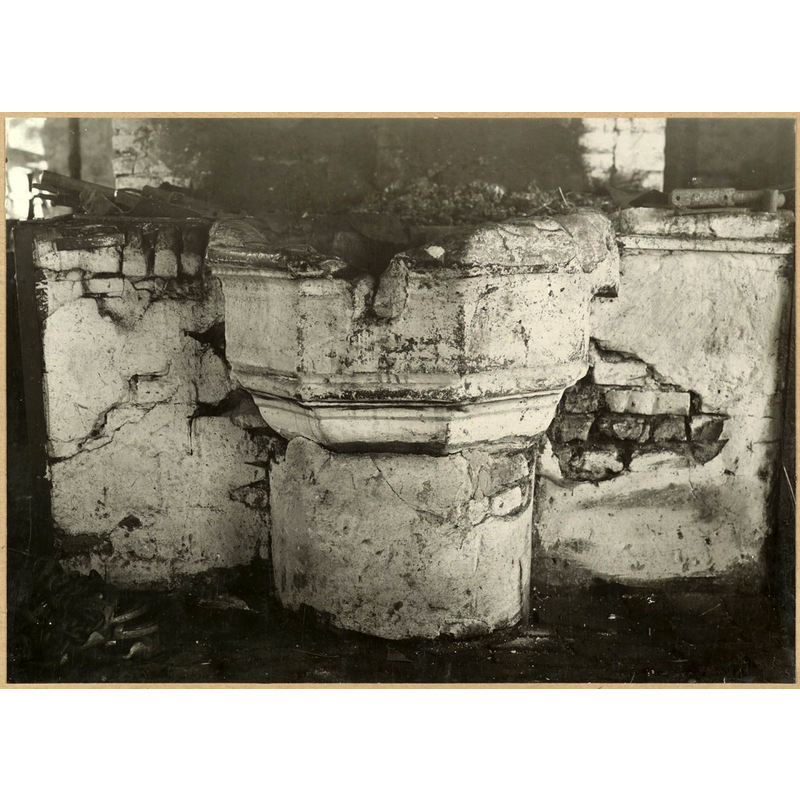Wiel nr. Buren / Whiel

Results: 1 records
view of font in context
Scene Description: the baptismal font in March 1928 being used as cooling vat in a forge at Eck en Wiel -- Source caption: "Nederlands Hervormde Kerk - Annakerk: Doopvont als koelbak in een smederij (opmerking: Bijschrift: Kuip v.e. doopvont aanwezig als koelbak in een smederij te Eck en Wiel (toestand in Maart 1928). Dit doopvont zou afkomstig zijn uit een vroeger kerkje, dat nabij het vm. Huis Wiel gestaan moet hebben)"
INFORMATION
FontID: 23493WIE
Object Type: Baptismal Font1 (basin only)?
Church/Chapel: [Chapel of St. John the Baptist -- disappeared]
Church Patron Saints: St. John the Baptist
Country Name: Netherlands
Location: Gelderland
Directions to Site: The site of the disappeared church/chapel is located in the municipality of Buren, about 9 km SW of Veenendaal
Font Location in Church: [cf. FontNotes]
Century and Period: 15th - 16th century
Workshop/Group/Artisan: Hainaut type font?
Credit and Acknowledgements: We are grateful to Pol Herman for his help in documenting this font and the one at Eck en Wiel
Font Notes:
Click to view
A 1928 photograph in the 1928, in the Rijksdienst voor het Cultureel Erfgoed shows the octagonal basin of a stone baptismal font being used as cooling vat in a forge at the time; it is now known that this basin came from the disappeared church/chapel of St John the Baptist, also in Eck. Pol Herman reports in a 30 October 2021 e-mail to BSI: "I was puzzled and have continued to search. Now, I have found the confirmation of my presumption in: Aardrijkskundig woordenboek der Nederlanden, Deel 12. Author : A.J. van der Aa. Editor : Jacobus Noorduyn, Gorinchem, 1849, Page 375. Translation: Wiel formerly known as Whiel, hamlet in the Lower Betuwe, .... This hamlet is first mentioned in the year 1347. There used to be a chapel here, the baptismal font of which was excavated some years ago on the spot where the chapel stood. Currently still used at the village blacksmith in Eck as a cooling vessel. The St. Anna Church is a late Gothic village church, a so-called pseudo-basilica. Founded around 1266 and dedicated (dedicated) to St. Anna (gifted). Probably because the founder's mother Bartholomew van Eck was called Anna. The original church was destroyed around 1363 during disputes between the Bronckhorsten and the van Heeckerens (the reason is unknown). Reconstruction was soon started, but progressed slowly. Thus, the tower dates from the 14th century, the nave from the end of the 15th and early 16th century and the choir from the 16th century. The pulpit dates from the 17th century (after the reformation), the base was originally from a 15th century baptismal font. I found information and a picture in : "De Betuwe. Authors R.F.P. de Beaufort en Herma M. van den Berg Staatsuitgeverij, Den Haag 1968, Page 338, picture 325. To me, this is undoubtedly the base of a late-gothic Mosan bluestone baptismal font (because the triangular diamants are deduplicated).
Eck used to belong to the diocese of Liège and is close to the Meuse river. I am not surprised that a “Walloon” baptismal font had been installed.
Now I discover that a basin is known in Eck and Wiel : https://commons.wikimedia.org/wiki/File:Doopvont_als_koelbak_in_een_smederij_-_Eck_en_Wiel_-_20324163_-_RCE.jpg -- Dutch Reformed Church - Annakerk: Baptismal font as a cooling trough in a smithy (Note: Caption: Basin of a baptismal font present as a cooling trough in a smithy in Eck en Wiel (condition in March 1928). This baptismal font is said to have come from an earlier church, which must have stood near the former House Wiel). In my opinion, the base+column of Eck and the basin of Wiel do not fit. The basin does not seem Mosan to me, but rather Hainaut-type. Then I read in the same document “De Betuwe”: There used to be a chapel in Wiel, which was dedicated to St. John the Baptist (source : De Navorscher; middel tot gedachtenwisseling en letterkundig verkeer, Amsterdam 1903, p. 354), and in which a vicar was established (source : W. Wijnaendts van Resandt, De vicarieën in Gelderland enz. Amsterdam 1943, p. 112). After the Reformation, this chapel, which before that time belonged to Ingen, was united with the ecclesiastical community of Eck. Therefore I would presume that the base+column are from the mosan-type late gothic font of the Saint-Anna church in Eck. And the basin is from a gothic Hainaut-type font of the lost chapel of Wiel. The fact that this chapel was named after St. John the Baptist suggests that it had baptismal rights. [cf. BSI entry for Eck en Wiel No. 1 for the font in Eck en Wiel St. Ann's].
MEDIUM AND MEASUREMENTS
Material: stone
Font Shape: octagonal (mounted)
Basin Interior Shape: round
Basin Exterior Shape: octagonal